Prediction of Multi-Scalar Standardized Precipitation Index by Using Artificial Intelligence and Regression Models
Abstract
1. Introduction
2. Materials and Methods
2.1. Study Area and Data Assembly
2.2. Standardized Precipitation Index (SPI)
2.3. Co-Active Neuro-Fuzzy Inference System (CANFIS)

2.4. Multi-Layer Perceptron Neural Network (MLPNN)
2.5. Multiple Linear Regression (MLR)
2.6. Input Selection and Model Development
2.7. Performance Indicators
3. Results
3.1. Significant Lags’ Nomination by Using PACF Analysis
3.2. Application of AI and Regression Models for Multi-Scalar SPI Prediction
3.3. Performance Assessment by Using Scatter Plots and Taylor Diagram
4. Discussion
5. Conclusions
Author Contributions
Funding
Institutional Review Board Statement
Informed Consent Statement
Acknowledgments
Conflicts of Interest
References
- Dracup, J.A.; Lee, K.S.; Paulson, E.G. On the statistical characteristics of drought events. Water Resour. Res. 1980, 16, 289–296. [Google Scholar] [CrossRef]
- Wilhite, D.A.; Glantz, M.H. Understanding the drought phenomenon: The role of definitions. Water Int. 1985, 10, 111–120. [Google Scholar] [CrossRef]
- Mishra, A.K.; Singh, V.P. Analysis of drought severity-area-frequency curves using a general circulation model and scenario uncertainty. J. Geophys. Res. 2009, 114, D06120. [Google Scholar] [CrossRef]
- Mishra, A.K.; Singh, V.P. A review of drought concepts. J. Hydrol. 2010, 391, 202–216. [Google Scholar] [CrossRef]
- Mishra, A.K.; Singh, V.P. Drought modeling—A review. J. Hydrol. 2011, 403, 157–175. [Google Scholar] [CrossRef]
- McKee, T.B.; Doesken, N.J.; Kleist, J. The relationship of drought frequency and duration to time scales. In Proceedings of the Eighth Conference on Applied Climatology, Anaheim, CA, USA, 17–22 January 1993. [Google Scholar]
- Mishra, A.K.; Desai, V.R. Drought forecasting using feed-forward recursive neural network. Ecol. Modell. 2006, 198, 127–138. [Google Scholar] [CrossRef]
- Morid, S.; Smakhtin, V.; Bagherzadeh, K. Drought forecasting using artificial neural networks and time series of drought indices. Int. J. Climatol. 2007, 27, 2103–2111. [Google Scholar] [CrossRef]
- Bacanli, U.G.; Firat, M.; Dikbas, F. Adaptive Neuro-Fuzzy Inference System for drought forecasting. Stoch. Environ. Res. Risk Assess. 2009, 23, 1143–1154. [Google Scholar] [CrossRef]
- Belayneh, A.; Adamowski, J. Standard Precipitation Index Drought Forecasting Using Neural Networks, Wavelet Neural Networks, and Support Vector Regression. Appl. Comput. Intell. Soft Comput. 2012, 2012, 1–13. [Google Scholar] [CrossRef]
- Özger, M.; Mishra, A.K.; Singh, V.P. Long Lead Time Drought Forecasting Using a Wavelet and Fuzzy Logic Combination Model: A Case Study in Texas. J. Hydrometeorol. 2012, 13, 284–297. [Google Scholar] [CrossRef]
- Deo, R.C.; Şahin, M. Application of the Artificial Neural Network model for prediction of monthly Standardized Precipitation and Evapotranspiration Index using hydrometeorological parameters and climate indices in eastern Australia. Atmos. Res. 2015, 161–162, 65–81. [Google Scholar] [CrossRef]
- Nguyen, L.B.; Li, Q.F.; Ngoc, T.A.; Hiramatsu, K. Adaptive Neuro-Fuzzy Inference System for drought forecasting in the Cai River basin in Vietnam. J. Fac. Agric. Kyushu Univ. 2015, 60, 405–415. [Google Scholar]
- Djerbouai, S.; Souag-Gamane, D. Drought Forecasting Using Neural Networks, Wavelet Neural Networks, and Stochastic Models: Case of the Algerois Basin in North Algeria. Water Resour. Manag. 2016, 30, 2445–2464. [Google Scholar] [CrossRef]
- Deo, R.C.; Tiwari, M.K.; Adamowski, J.F.; Quilty, J.M. Forecasting effective drought index using a wavelet extreme learning machine (W-ELM) model. Stoch. Environ. Res. Risk Assess. 2017, 31, 1211–1240. [Google Scholar] [CrossRef]
- Komasi, M.; Sharghi, S.; Safavi, H.R. Wavelet and cuckoo search-support vector machine conjugation for drought forecasting using Standardized Precipitation Index (case study: Urmia Lake, Iran). J. Hydroinf. 2018, 20, 975–988. [Google Scholar] [CrossRef]
- Abbasi, A.; Khalili, K.; Behmanesh, J.; Shirzad, A. Drought monitoring and prediction using SPEI index and gene expression programming model in the west of Urmia Lake. Theor. Appl. Climatol. 2019, 138, 553–567. [Google Scholar] [CrossRef]
- Memarian, H.; Pourreza Bilondi, M.; Rezaei, M. Drought prediction using co-active neuro-fuzzy inference system, validation, and uncertainty analysis (case study: Birjand, Iran). Theor. Appl. Climatol. 2016, 125, 541–554. [Google Scholar] [CrossRef]
- Rafiei-Sardooi, E.; Mohseni-Saravi, M.; Barkhori, S.; Azareh, A.; Choubin, B.; Jafari-Shalamzar, M. Drought modeling: A comparative study between time series and neuro-fuzzy approaches. Arab. J. Geosci. 2018, 11, 1–9. [Google Scholar] [CrossRef]
- Malik, A.; Kumar, A.; Salih, S.Q.; Kim, S.; Kim, N.W.; Yaseen, Z.M.; Singh, V.P. Drought index prediction using advanced fuzzy logic model: Regional case study over Kumaon in India. PLoS ONE 2020, 15, e0233280. [Google Scholar] [CrossRef]
- Guttman, N.B. Comparing the palmer drought index and the standardized precipitation index. J. Am. Water Resour. Assoc. 1998, 34, 113–121. [Google Scholar] [CrossRef]
- Hayes, M.J.; Svoboda, M.D.; Wilhite, D.A.; Vanyarkho, O.V. Monitoring the 1996 Drought Using the Standardized Precipitation Index. Bull. Am. Meteorol. Soc. 1999, 80, 429–438. [Google Scholar] [CrossRef]
- Angelidis, P.; Maris, F.; Kotsovinos, N.; Hrissanthou, V. Computation of Drought Index SPI with Alternative Distribution Functions. Water Resour. Manag. 2012, 26, 2453–2473. [Google Scholar] [CrossRef]
- Yacoub, E.; Tayfur, G. Evaluation and Assessment of Meteorological Drought by Different Methods in Trarza Region, Mauritania. Water Resour. Manag. 2017, 31, 825–845. [Google Scholar] [CrossRef]
- Lloyd-Hughes, B.; Saunders, M.A. A drought climatology for Europe. Int. J. Climatol. 2002, 22, 1571–1592. [Google Scholar] [CrossRef]
- Mishra, A.K.; Desai, V.R. Spatial and temporal drought analysis in the Kansabati river basin, India. Int. J. River Basin Manag. 2005, 3, 31–41. [Google Scholar] [CrossRef]
- Abramowitz, M.; Stegun, A. Handbook of Mathematical Formulas, Graphs, and Mathematical Tables; Dover Publishing: New York, NY, USA, 1965; p. 470. [Google Scholar]
- Edwards, D.C.; McKee, T.B. Characteristics of 20th Century drought in the United States at multiple time scales. Atmos. Sci. Pap. 1997. [Google Scholar]
- Jang, J.-S.R.; Sun, C.-T.; Mizutani, E. Neuro-Fuzzy and Soft Computing A Computational Approach to Learning and Machine Intelligence; Prentice Hall: Upper Saddle River, NJ, USA, 1997; ISBN 0132610663. [Google Scholar]
- Malik, A.; Kumar, A. Pan Evaporation Simulation Based on Daily Meteorological Data Using Soft Computing Techniques and Multiple Linear Regression. Water Resour. Manag. 2015, 29, 1859–1872. [Google Scholar] [CrossRef]
- Malik, A.; Kumar, A. Meteorological drought prediction using heuristic approaches based on effective drought index: A case study in Uttarakhand. Arab. J. Geosci. 2020, 13, 1–17. [Google Scholar] [CrossRef]
- Malik, A.; Kumar, A.; Piri, J. Daily suspended sediment concentration simulation using hydrological data of Pranhita River Basin, India. Comput. Electron. Agric. 2017, 138, 20–28. [Google Scholar] [CrossRef]
- Malik, A.; Kumar, A.; Kisi, O. Monthly pan-evaporation estimation in Indian central Himalayas using different heuristic approaches and climate based models. Comput. Electron. Agric. 2017, 143, 302–313. [Google Scholar] [CrossRef]
- Singh, A.; Malik, A.; Kumar, A.; Kisi, O. Rainfall-runoff modeling in hilly watershed using heuristic approaches with gamma test. Arab. J. Geosci. 2018, 11, 1–12. [Google Scholar] [CrossRef]
- Sugeno, M.; Kang, G. Structure identification of fuzzy model. Fuzzy Sets Syst. 1988, 28, 15–33. [Google Scholar] [CrossRef]
- Takagi, T.; Sugeno, M. Fuzzy identification of systems and its applications to modeling and control. IEEE Trans. Syst. Man. Cybern. 1985, SMC-15, 116–132. [Google Scholar] [CrossRef]
- Aytek, A. Co-active neurofuzzy inference system for evapotranspiration modeling. Soft Comput. 2009, 13, 691–700. [Google Scholar] [CrossRef]
- Tabari, H.; Talaee, P.H.; Abghari, H. Utility of coactive neuro-fuzzy inference system for pan evaporation modeling in comparison with multilayer perceptron. Meteorol. Atmos. Phys. 2012, 116, 147–154. [Google Scholar] [CrossRef]
- Haykin, S. Neural Networks—A Comprehensive Foundation, 2nd ed.; Prentice-Hall International, Inc.: Upper Saddle River, NJ, USA, 1999; pp. 26–32. [Google Scholar]
- Dawson, C.W.; Wilby, R.L. Hydrological modelling using artificial neural networks. Prog. Phys. Geogr. Earth Environ. 2001, 25, 80–108. [Google Scholar] [CrossRef]
- Landeras, G.; Ortiz-Barredo, A.; López, J.J. Forecasting Weekly Evapotranspiration with ARIMA and Artificial Neural Network Models. J. Irrig. Drain. Eng. 2009, 135, 323–334. [Google Scholar] [CrossRef]
- Deo, R.C.; Kisi, O.; Singh, V.P. Drought forecasting in eastern Australia using multivariate adaptive regression spline, least square support vector machine and M5Tree model. Atmos. Res. 2017, 184, 149–175. [Google Scholar] [CrossRef]
- Douglas, E.M.; Vogel, R.M.; Kroll, C.N. Trends in floods and low flows in the United States: Impact of spatial correlation. J. Hydrol. 2000, 240, 90–105. [Google Scholar] [CrossRef]
- Nash, J.E.; Sutcliffe, J.V. River flow forecasting through conceptual models part I—A discussion of principles. J. Hydrol. 1970, 10, 282–290. [Google Scholar] [CrossRef]
- Moriasi, D.N.; Gitau, M.W.; Pai, N.; Daggupati, P. Hydrologic and Water Quality Models: Performance Measures and Evaluation Criteria. Trans. ASABE 2015, 58, 1763–1785. [Google Scholar]
- Willmott, C.J. On the validation of models. Phys. Geogr. 1981, 2, 184–194. [Google Scholar] [CrossRef]
- Taylor, K.E. Summarizing multiple aspects of model performance in a single diagram. J. Geophys. Res. Atmos. 2001, 106, 7183–7192. [Google Scholar] [CrossRef]
- Mokhtarzad, M.; Eskandari, F.; Jamshidi Vanjani, N.; Arabasadi, A. Drought forecasting by ANN, ANFIS, and SVM and comparison of the models. Environ. Earth Sci. 2017, 76, 729. [Google Scholar] [CrossRef]
- Nguyen, V.; Li, Q.; Nguyen, L. Drought forecasting using ANFIS- a case study in drought prone area of Vietnam. Paddy Water Environ. 2017, 15, 605–616. [Google Scholar] [CrossRef]
- Zhang, Y.; Li, W.; Chen, Q.; Pu, X.; Xiang, L. Multi-models for SPI drought forecasting in the north of Haihe River Basin, China. Stoch. Environ. Res. Risk Assess. 2017, 31, 2471–2481. [Google Scholar] [CrossRef]
- Liu, Z.; Li, Q.; Nguyen, L.; Xu, G. Comparing Machine-Learning Models for Drought Forecasting in Vietnam’s Cai River Basin. Pol. J. Environ. Stud. 2018, 27, 2633–2646. [Google Scholar] [CrossRef]
- Mouatadid, S.; Raj, N.; Deo, R.C.; Adamowski, J.F. Input selection and data-driven model performance optimization to predict the Standardized Precipitation and Evaporation Index in a drought-prone region. Atmos. Res. 2018, 212, 130–149. [Google Scholar] [CrossRef]
- Özger, M.; Başakın, E.E.; Ekmekcioğlu, Ö.; Hacısüleyman, V. Comparison of wavelet and empirical mode decomposition hybrid models in drought prediction. Comput. Electron. Agric. 2020, 179, 105851. [Google Scholar] [CrossRef]
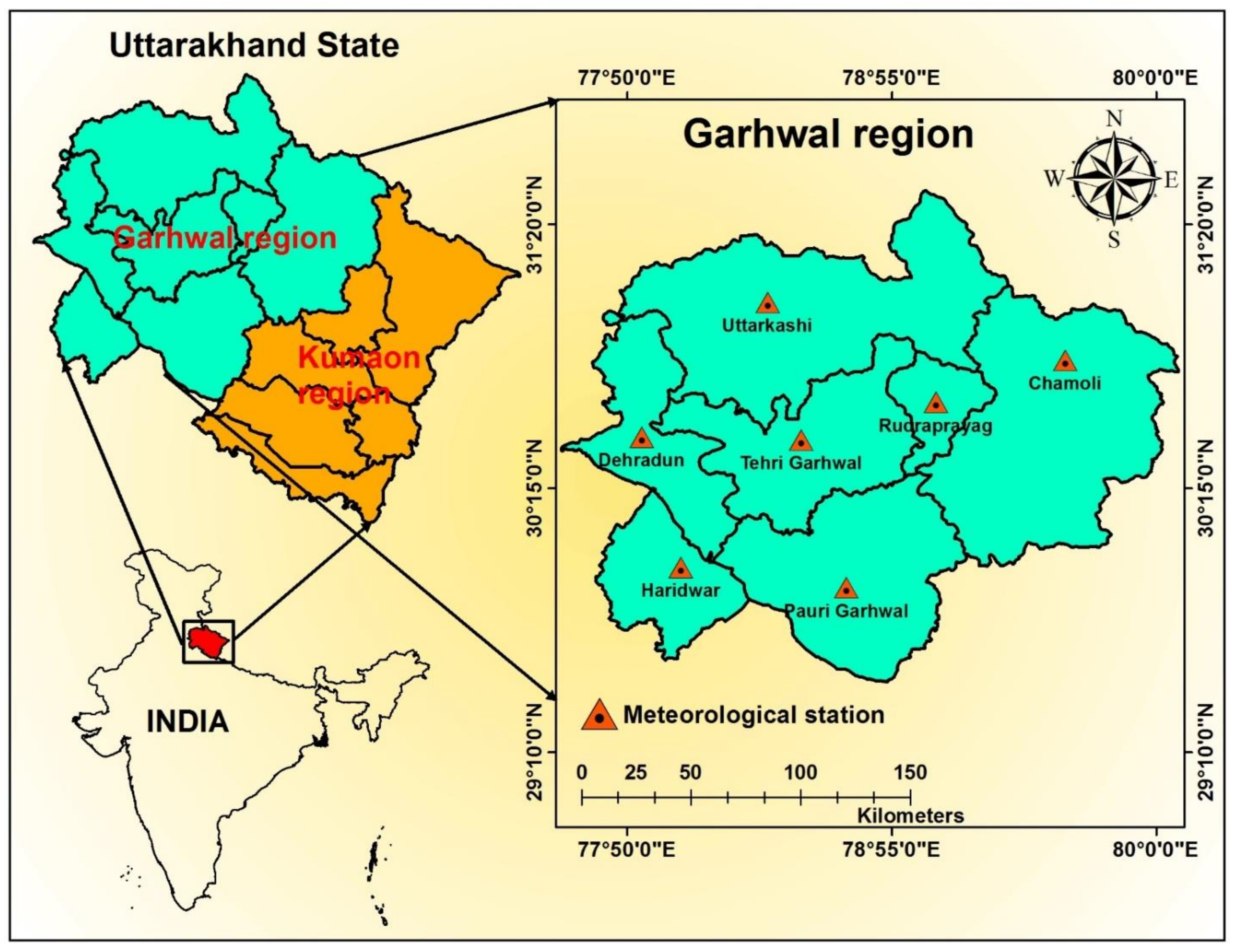

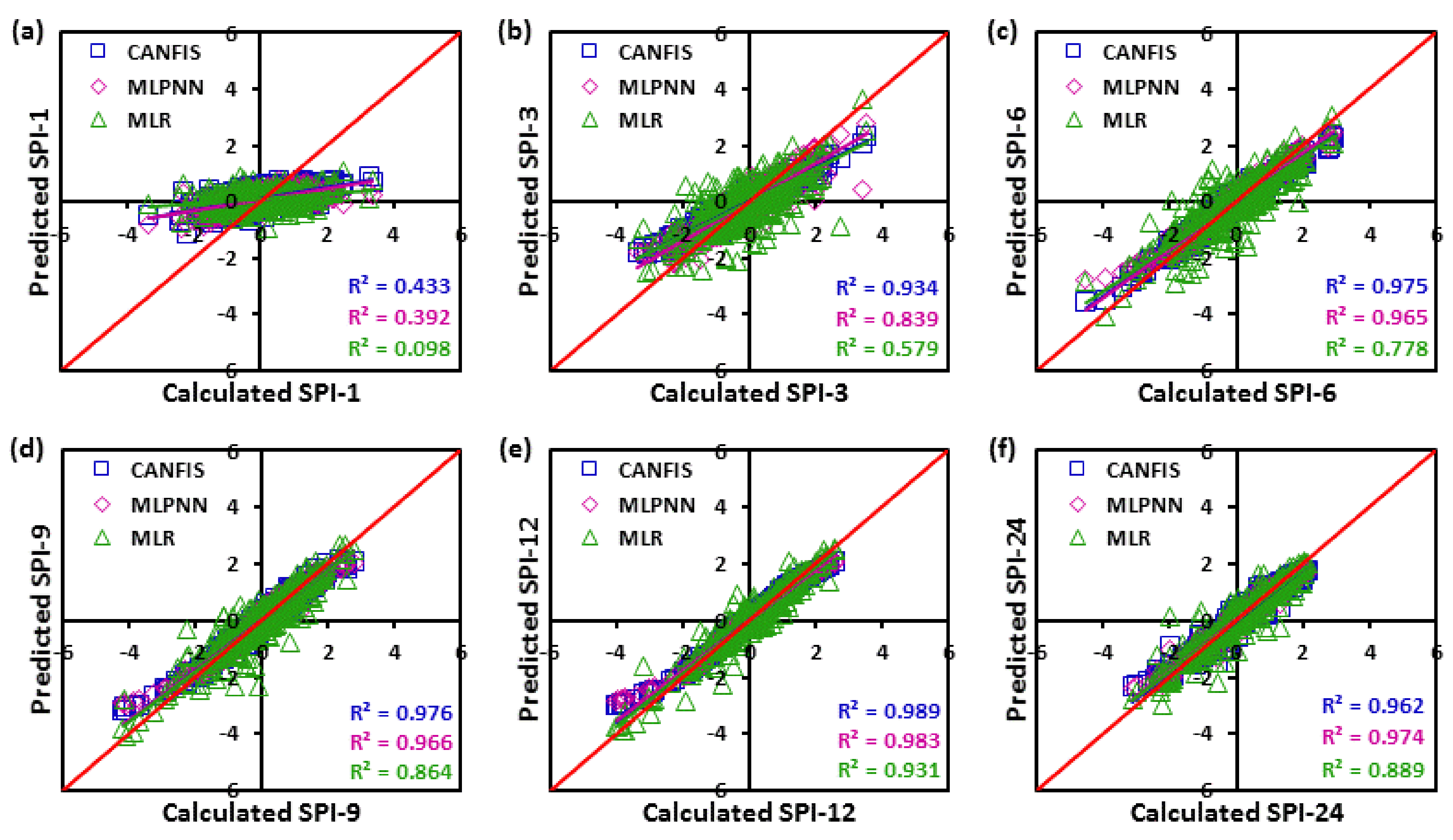


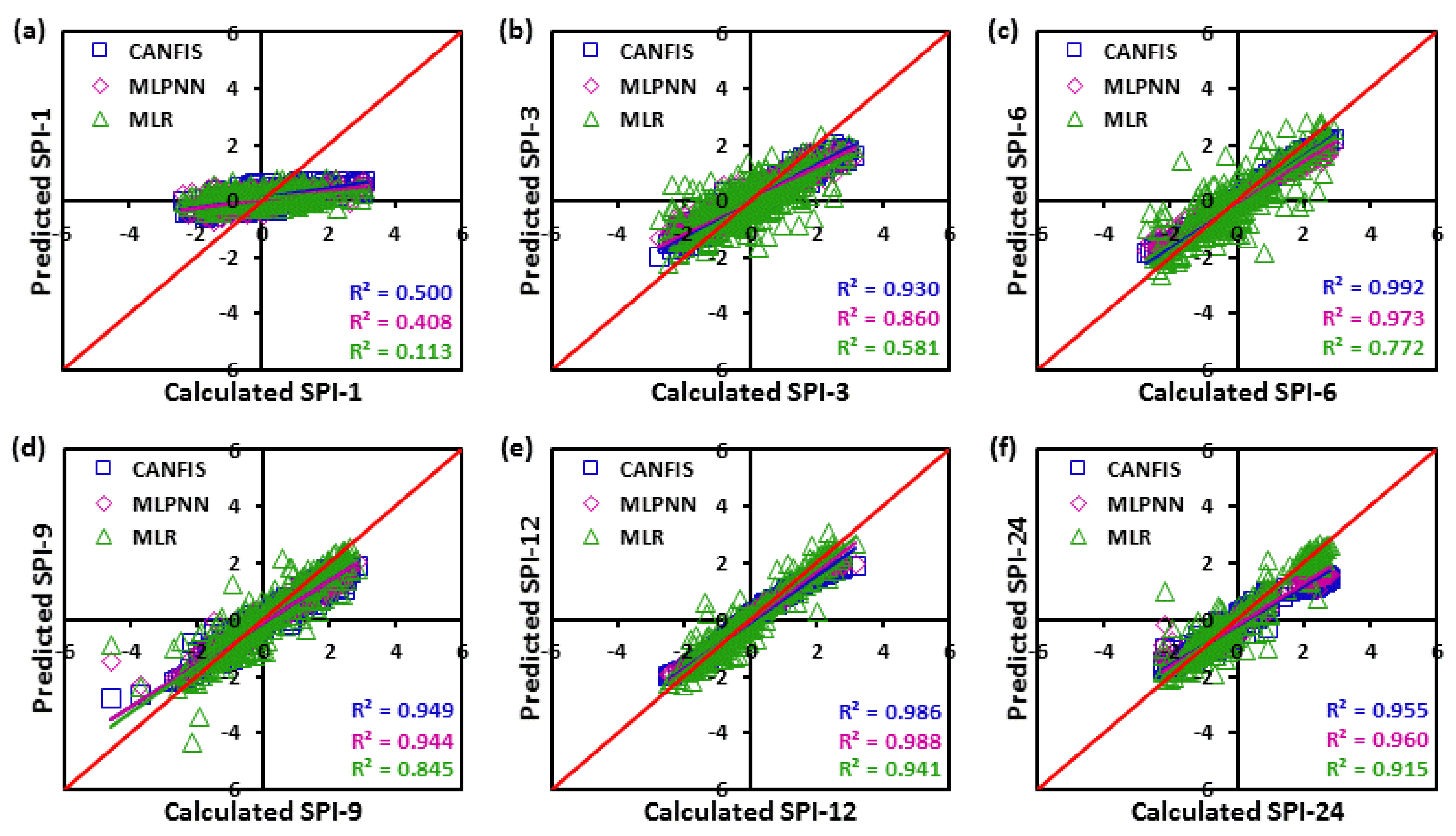
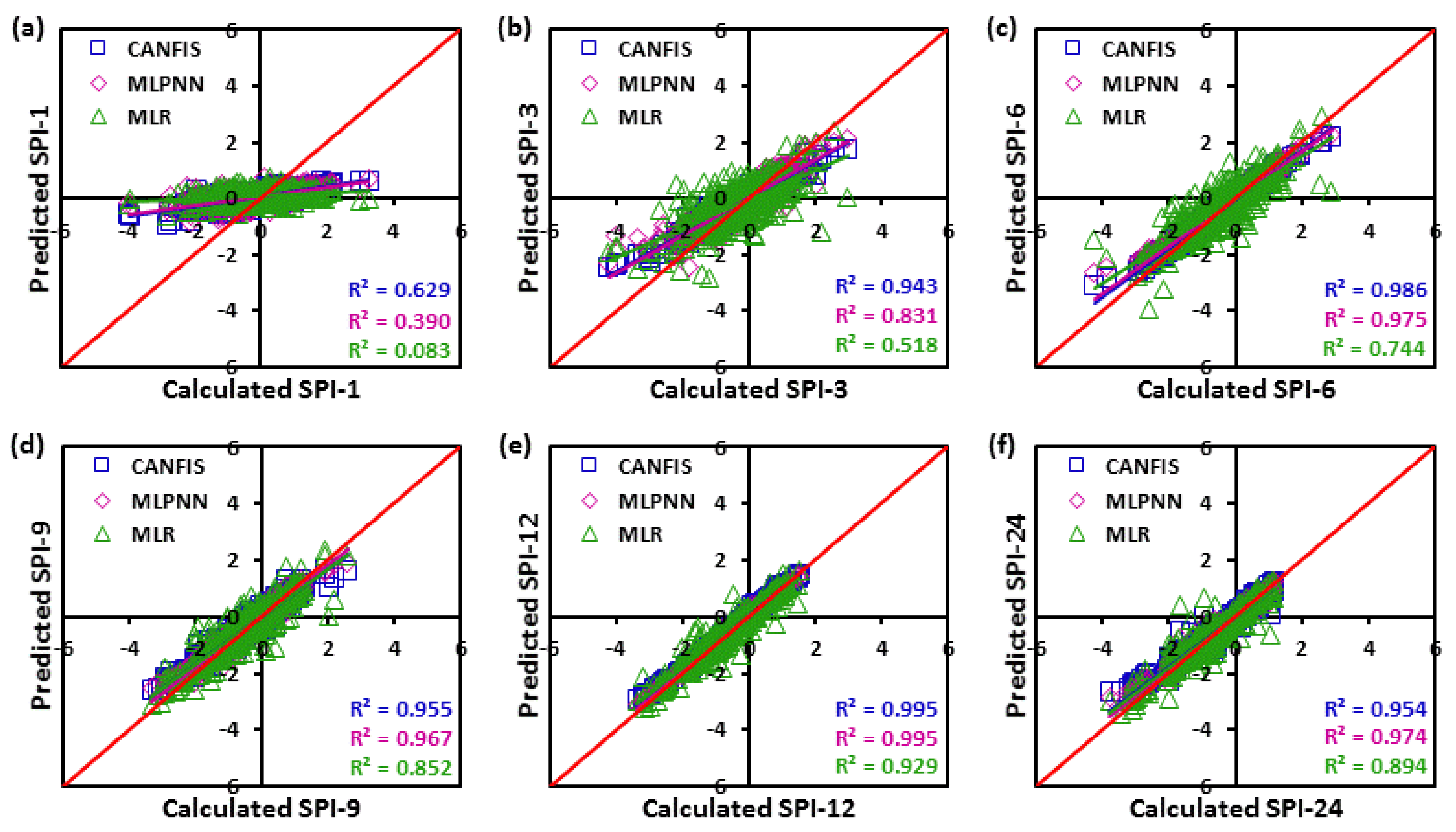
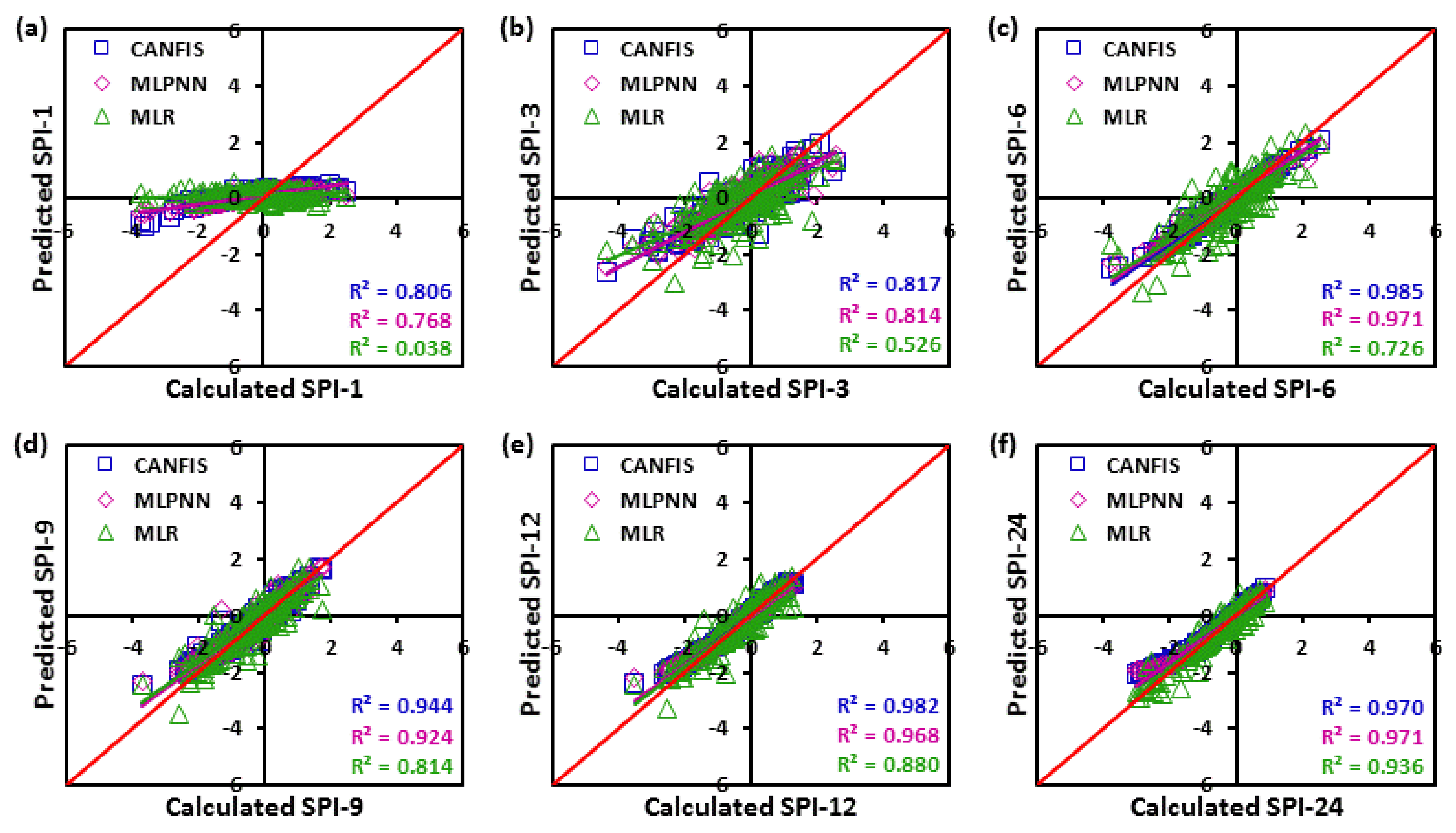

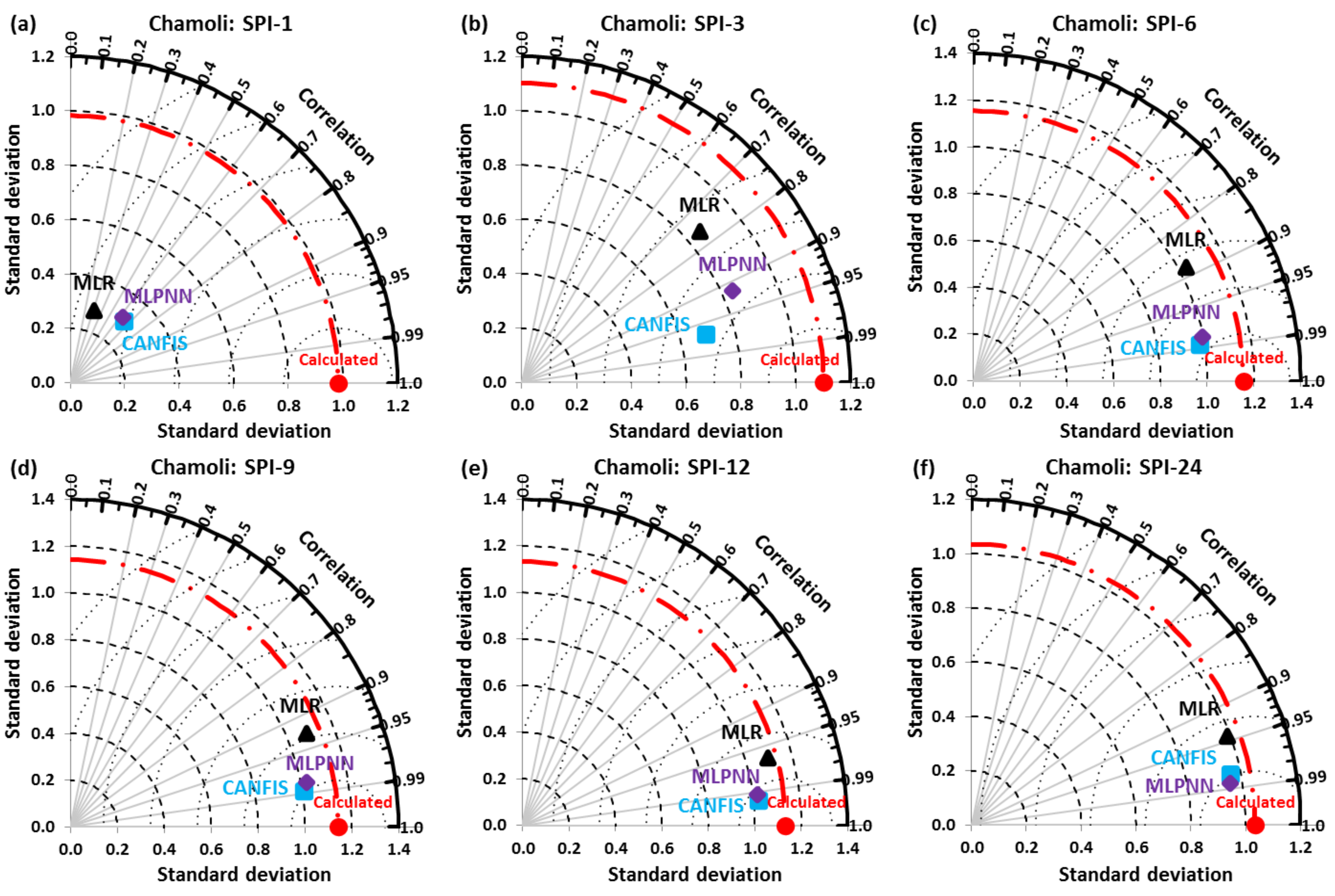

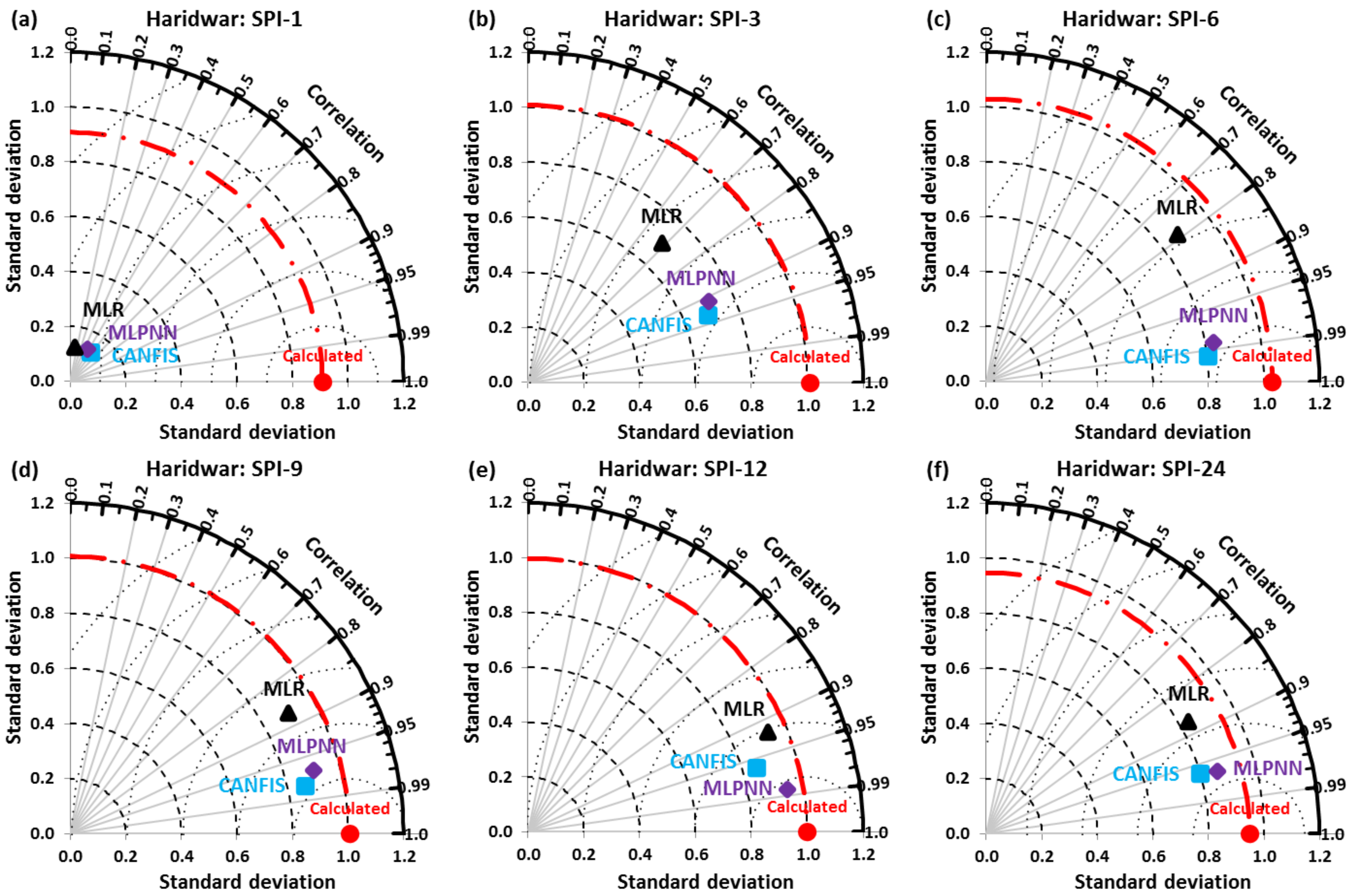

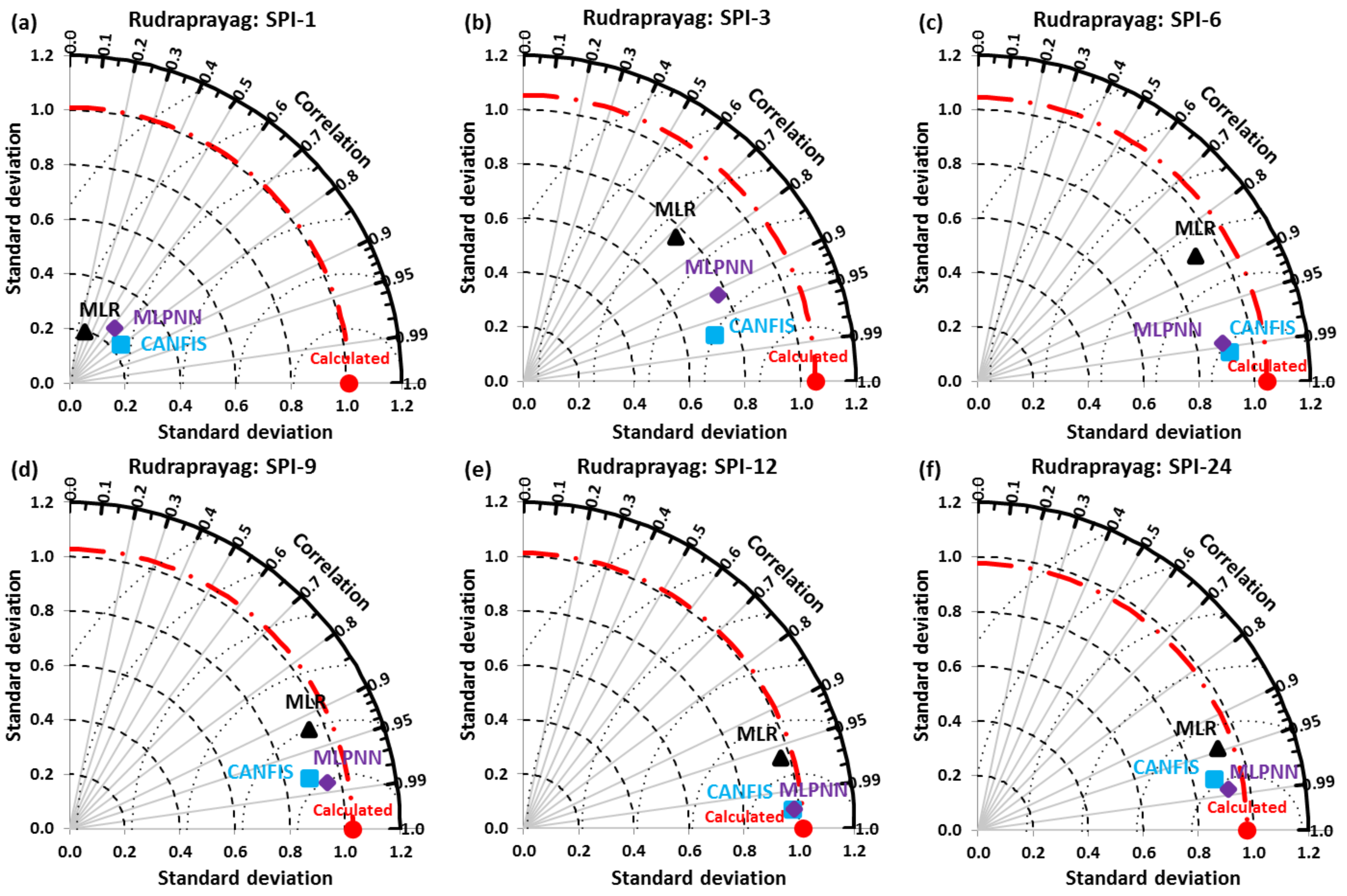

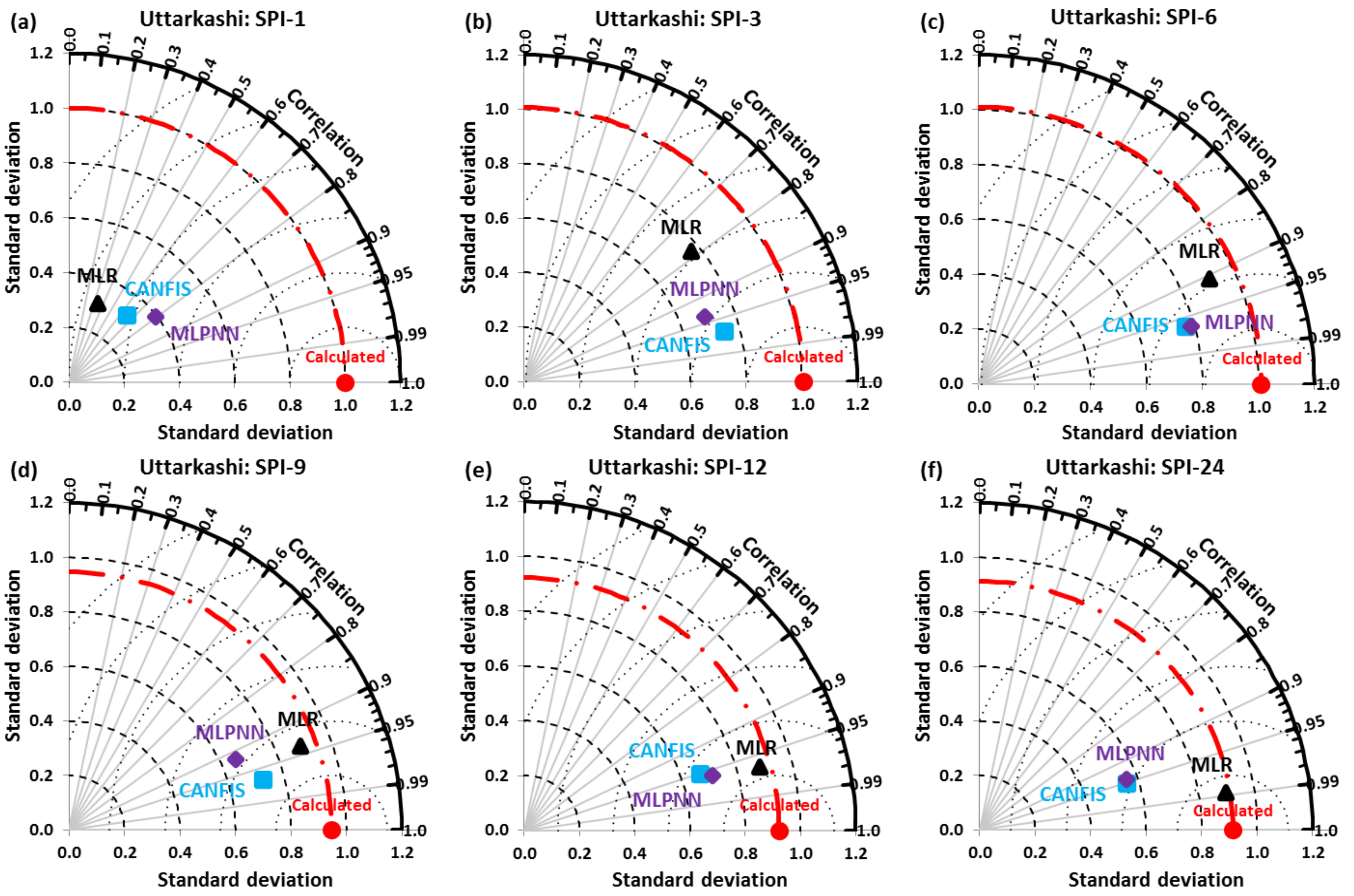
| Meteorological Station | Latitude (N) | Longitude (E) | Altitude (m) | Rainfall Data (Year) |
|---|---|---|---|---|
| Chamoli | 30°46′30″ | 79°37′41″ | 5046 | 1901–2015 |
| Dehradun | 30°27′32″ | 77°53′28″ | 728 | 1901–2015 |
| Haridwar | 29°55′26″ | 78°03′04″ | 276 | 1901–2015 |
| Pauri Garhwal | 29°50′28″ | 78°43′44″ | 1134 | 1901–2015 |
| Rudraprayag | 30°36′07″ | 79°05′53″ | 2117 | 1901–2015 |
| Tehri Garhwal | 30°26′53″ | 78°32′42″ | 1996 | 1955–2015 |
| Uttarkashi | 31°00′47″ | 78°24′29″ | 3366 | 1951–2015 |
| Station | Index | Lag | |||||||||||
|---|---|---|---|---|---|---|---|---|---|---|---|---|---|
| 1 | 2 | 3 | 4 | 5 | 6 | 7 | 8 | 9 | 10 | 11 | 12 | ||
| Chamoli | SPI-1 | 0.213 * | 0.048 | 0.021 | 0.031 | 0.043 | 0.045 | 0.041 | 0.038 | 0.063 * | 0.081 * | 0.074 * | 0.135 * |
| SPI-3 | 0.725 * | −0.180 * | −0.150 * | 0.236 * | 0.000 | −0.041 | 0.146 * | 0.058 * | 0.040 | 0.129 * | 0.055 * | 0.050 | |
| SPI-6 | 0.881 * | −0.172 * | −0.071 * | −0.042 | −0.018 | −0.024 | 0.416 * | −0.002 | 0.036 | −0.016 | −0.073 * | −0.072 * | |
| SPI-9 | 0.934 * | −0.112 * | −0.025 | 0.015 | −0.038 | −0.015 | 0.011 | −0.055 * | −0.031 | 0.390 * | −0.073 * | −0.062 * | |
| SPI-12 | 0.963 * | −0.150 * | −0.001 | 0.016 | −0.048 | −0.054 * | −0.037 | −0.020 | −0.038 | −0.083 * | −0.075 * | 0.011 | |
| SPI-24 | 0.949 * | 0.342 * | 0.149 * | 0.025 | −0.027 | −0.060 * | 0.040 | 0.020 | −0.003 | −0.047 | −0.110 * | −0.068 * | |
| UCL/LCL | ±0.053 | ±0.053 | ±0.053 | ±0.053 | ±0.053 | ±0.053 | ±0.053 | ±0.053 | ±0.053 | ±0.053 | ±0.053 | ±0.053 | |
| Dehradun | SPI-1 | 0.134 * | 0.019 | −0.053 | −0.059 * | 0.033 | −0.031 | 0.001 | −0.005 | −0.026 | 0.031 | 0.078 * | 0.056 * |
| SPI-3 | 0.659 * | −0.176 * | −0.209 * | 0.167 * | 0.001 | −0.095 * | 0.072 * | 0.017 | 0.032 | 0.047 | 0.047 | 0.020 | |
| SPI-6 | 0.818 * | −0.149 * | −0.059 * | −0.009 | −0.044 | −0.111 * | 0.250 * | 0.014 | 0.037 | 0.034 | 0.002 | −0.089 * | |
| SPI-9 | 0.875 * | −0.054 * | 0.072 * | 0.018 | −0.002 | −0.046 | −0.044 | −0.099 * | −0.135 * | 0.279 * | 0.044 | 0.008 | |
| SPI-12 | 0.951 * | −0.169 * | −0.057 * | −0.001 | −0.020 | −0.050 | −0.030 | −0.048 | −0.047 | −0.083 * | −0.049 | −0.022 | |
| SPI-24 | 0.932 * | 0.289 * | 0.084 * | 0.018 | 0.003 | 0.028 | 0.146 * | 0.074 * | −0.008 | −0.085 * | −0.093 * | −0.061 * | |
| UCL/LCL | ±0.053 | ±0.053 | ±0.053 | ±0.053 | ±0.053 | ±0.053 | ±0.053 | ±0.053 | ±0.053 | ±0.053 | ±0.053 | ±0.053 | |
| Haridwar | SPI-1 | 0.101 * | 0.008 | −0.037 | −0.081 * | 0.029 | −0.015 | −0.020 | −0.003 | −0.044 | 0.032 | 0.010 | 0.039 |
| SPI-3 | 0.639 * | −0.141 * | −0.246 * | 0.165 * | 0.000 | −0.101 * | 0.078 * | −0.013 | −0.022 | 0.001 | −0.008 | 0.005 | |
| SPI-6 | 0.796 * | −0.109 * | −0.079 * | −0.032 | −0.042 | −0.192 * | 0.237 * | −0.021 | −0.022 | −0.014 | −0.056 * | −0.074 * | |
| SPI-9 | 0.857 * | 0.030 | −0.035 | −0.060 * | −0.047 | −0.072 * | −0.068 * | −0.116 * | −0.208 * | 0.288 * | 0.012 | 0.026 | |
| SPI-12 | 0.924 * | −0.143 * | −0.079 * | −0.033 | −0.029 | −0.065 * | −0.064 * | −0.054 * | −0.100 * | −0.110 * | −0.100 * | −0.044 | |
| SPI-24 | 0.870 * | 0.287 * | 0.073 * | −0.007 | −0.018 | 0.068 * | 0.112 * | 0.052 | −0.033 | −0.103 * | −0.103 * | −0.058 * | |
| UCL/LCL | ±0.053 | ±0.053 | ±0.053 | ±0.053 | ±0.053 | ±0.053 | ±0.053 | ±0.053 | ±0.053 | ±0.053 | ±0.053 | ±0.053 | |
| Pauri Garhwal | SPI-1 | 0.210 * | 0.033 | 0.013 | −0.041 | 0.058 * | 0.002 | 0.005 | 0.016 | −0.019 | 0.057 * | 0.073 * | 0.084 * |
| SPI-3 | 0.696 * | −0.145 * | −0.140 * | 0.181 * | 0.017 | −0.047 | 0.058 * | 0.005 | 0.051 | 0.075 * | 0.051 | 0.047 | |
| SPI-6 | 0.857 * | −0.103 * | −0.042 | −0.043 | −0.001 | −0.109 * | 0.243 * | 0.003 | 0.066 * | 0.052 | −0.023 | −0.062 * | |
| SPI-9 | 0.898 * | −0.013 | 0.039 | −0.008 | 0.024 | −0.049 | −0.038 | −0.068 * | −0.116 * | 0.281 * | 0.045 | 0.031 | |
| SPI-12 | 0.959 * | −0.100 * | −0.100 * | −0.033 | 0.001 | −0.074 * | −0.050 | 0.001 | −0.038 | −0.035 | −0.018 | −0.036 | |
| SPI-24 | 0.944 * | 0.314 * | 0.079 * | 0.005 | 0.014 | 0.025 | 0.104 * | 0.082 * | −0.007 | −0.073 * | −0.078 * | −0.041 | |
| UCL/LCL | ±0.053 | ±0.053 | ±0.053 | ±0.053 | ±0.053 | ±0.053 | ±0.053 | ±0.053 | ±0.053 | ±0.053 | ±0.053 | ±0.053 | |
| Rudraprayag | SPI-1 | 0.197 * | 0.014 | 0.002 | −0.003 | 0.075 * | 0.049 | 0.038 | 0.030 | 0.007 | 0.055 * | 0.068 * | 0.084 * |
| SPI-3 | 0.697 * | −0.172 * | −0.100 * | 0.224 * | 0.054 * | −0.051 | 0.081 * | 0.048 | 0.024 | 0.084 * | 0.045 | 0.017 | |
| SPI-6 | 0.866 * | −0.099 * | 0.015 | −0.027 | −0.039 | −0.083 * | 0.265 * | 0.015 | 0.042 | 0.038 | −0.026 | −0.102 * | |
| SPI-9 | 0.916 * | −0.060 * | 0.063 * | 0.009 | 0.025 | −0.067 * | −0.057 * | −0.105 * | −0.096 * | 0.311 * | 0.033 | −0.013 | |
| SPI-12 | 0.965 * | −0.165 * | −0.058 * | −0.033 | −0.011 | −0.063 * | −0.035 | −0.008 | −0.036 | −0.049 | −0.035 | −0.009 | |
| SPI-24 | 0.949 * | 0.320 * | 0.098 * | −0.005 | −0.011 | 0.025 | 0.076 * | 0.127 * | −0.025 | −0.120 * | −0.130 * | −0.010 | |
| UCL/LCL | ±0.053 | ±0.053 | ±0.053 | ±0.053 | ±0.053 | ±0.053 | ±0.053 | ±0.053 | ±0.053 | ±0.053 | ±0.053 | ±0.053 | |
| Tehri Garhwal | SPI-1 | 0.157 * | 0.050 | −0.020 | 0.049 | 0.076 * | 0.010 | 0.007 | 0.040 | 0.006 | 0.054 | 0.064 | 0.008 |
| SPI-3 | 0.692 * | −0.125 * | −0.162 * | 0.282 * | −0.009 | −0.064 | 0.088 * | 0.011 | 0.052 | 0.021 | 0.039 | −0.001 | |
| SPI-6 | 0.851 * | −0.093 * | 0.001 | −0.025 | −0.055 | −0.119 * | 0.287 * | −0.026 | 0.035 | 0.016 | −0.040 | −0.079 * | |
| SPI-9 | 0.904 * | −0.009 | 0.010 | −0.017 | −0.020 | −0.051 | −0.070 | −0.082 * | −0.126 * | 0.344 * | 0.020 | −0.045 | |
| SPI-12 | 0.948 * | −0.085 * | −0.036 | −0.023 | −0.031 | −0.087 * | −0.054 | −0.004 | −0.048 | −0.062 | −0.066 | −0.082 * | |
| SPI-24 | 0.976 * | −0.137 * | −0.055 | −0.002 | −0.030 | −0.070 | −0.022 | 0.019 | −0.017 | −0.037 | −0.029 | −0.075 * | |
| UCL/LCL | ±0.073 | ±0.073 | ±0.073 | ±0.073 | ±0.073 | ±0.073 | ±0.073 | ±0.073 | ±0.073 | ±0.073 | ±0.073 | ±0.073 | |
| Uttarkashi | SPI-1 | 0.276 * | 0.116 * | 0.069 | 0.041 | 0.130 * | 0.104 * | 0.015 | 0.012 | 0.055 | 0.029 | 0.045 | 0.072 * |
| SPI-3 | 0.773 * | −0.114 * | −0.081 * | 0.273 * | 0.036 | −0.019 | 0.050 | 0.008 | 0.055 | 0.050 | 0.041 | 0.017 | |
| SPI-6 | 0.911 * | −0.151 * | −0.020 | −0.022 | −0.004 | −0.082 * | 0.264 * | −0.031 | 0.038 | −0.001 | −0.039 | −0.040 | |
| SPI-9 | 0.947 * | −0.144 * | −0.021 | 0.020 | −0.030 | −0.085 * | −0.076 * | −0.040 | −0.072 * | 0.316 * | −0.036 | 0.055 | |
| SPI-12 | 0.972 * | −0.255 * | −0.095 * | 0.007 | −0.020 | −0.095 * | −0.063 | 0.015 | 0.004 | −0.034 | 0.028 | 0.058 | |
| SPI-24 | 0.991 * | −0.196 * | −0.025 | −0.007 | 0.004 | −0.105 * | −0.102 * | −0.014 | −0.015 | −0.039 | −0.050 | 0.029 | |
| UCL/LCL | ±0.071 | ±0.071 | ±0.071 | ±0.071 | ±0.071 | ±0.071 | ±0.071 | ±0.071 | ±0.071 | ±0.071 | ±0.071 | ±0.071 | |
| Station | Output | Input Variables |
|---|---|---|
| Chamoli | SPI-1 | SPI-1t-1, SPI-1t-9, SPI-1t-10, SPI-1t-11, SPI-1t-12 |
| SPI-3 | SPI-3t-1, SPI-3t-2, SPI-3t-3, SPI-3t-4, SPI-3t-7, SPI-3t-8, SPI-3t-10, SPI-3t-11 | |
| SPI-6 | SPI-6t-1, SPI-6t-2, SPI-6t-3, SPI-6t-7, SPI-6t-11, SPI-6t-12 | |
| SPI-9 | SPI-9t-1, SPI-9t-2, SPI-9t-8, SPI-9t-10, SPI-9t-11, SPI-9t-12 | |
| SPI-12 | SPI-12t-1, SPI-12t-2, SPI-12t-6, SPI-12t-10, SPI-12t-11 | |
| SPI-24 | SPI-24t-1, SPI-24t-2, SPI-24t-3, SPI-24t-6, SPI-24t-11, SPI-24t-12 | |
| Dehradun | SPI-1 | SPI-1t-1, SPI-1t-4, SPI-1t-11, SPI-1t-12 |
| SPI-3 | SPI-3t-1, SPI-3t-2, SPI-3t-3, SPI-3t-4, SPI-3t-6, SPI-3t-7 | |
| SPI-6 | SPI-6t-1, SPI-6t-2, SPI-6t-3, SPI-6t-6, SPI-6t-7, SPI-6t-12 | |
| SPI-9 | SPI-9t-1, SPI-9t-2, SPI-9t-3, SPI-9t-8, SPI-9t-9, SPI-9t-10 | |
| SPI-12 | SPI-12t-1, SPI-12t-2, SPI-12t-3, SPI-12t-10 | |
| SPI-24 | SPI-24t-1, SPI-24t-2, SPI-24t-3, SPI-24t-7, SPI-24t-8, SPI-24t-10, SPI-24t-11, SPI-24t-12 | |
| Haridwar | SPI-1 | SPI-1t-1, SPI-1t-4 |
| SPI-3 | SPI-3t-1, SPI-3t-2, SPI-3t-3, SPI-3t-4, SPI-3t-6, SPI-3t-7 | |
| SPI-6 | SPI-6t-1, SPI-6t-2, SPI-6t-3, SPI-6t-6, SPI-6t-7, SPI-6t-11, SPI-6t-12 | |
| SPI-9 | SPI-9t-1, SPI-9t-4, SPI-9t-6, SPI-9t-7, SPI-9t-8, SPI-9t-9, SPI-9t-10 | |
| SPI-12 | SPI-12t-1, SPI-12t-2, SPI-12t-3, SPI-12t-6, SPI-12t-7, SPI-12t-8, SPI-12t-9, SPI-12t-10, SPI-12t-11 | |
| SPI-24 | SPI-24t-1, SPI-24t-2, SPI-24t-3, SPI-24t-6, SPI-24t-7, SPI-24t-10, SPI-24t-11, SPI-24t-12 | |
| Pauri Garhwal | SPI-1 | SPI-1t-1, SPI-1t-5, SPI-1t-10, SPI-1t-11, SPI-1t-12 |
| SPI-3 | SPI-3t-1, SPI-3t-2, SPI-3t-3, SPI-3t-4, SPI-3t-7, SPI-3t-10 | |
| SPI-6 | SPI-6t-1, SPI-6t-2, SPI-6t-6, SPI-6t-7, SPI-6t-9, SPI-6t-12 | |
| SPI-9 | SPI-9t-1, SPI-9t-8, SPI-9t-9, SPI-9t-10 | |
| SPI-12 | SPI-12t-1, SPI-12t-2, SPI-12t-3, SPI-12t-6 | |
| SPI-24 | SPI-24t-1, SPI-24t-2, SPI-24t-3, SPI-24t-7, SPI-24t-8, SPI-24t-10, SPI-24t-11 | |
| Rudraprayag | SPI-1 | SPI-1t-1, SPI-1t-5, SPI-1t-10, SPI-1t-11, SPI-1t-12 |
| SPI-3 | SPI-3t-1, SPI-3t-2, SPI-3t-3, SPI-3t-4, SPI-3t-5, SPI-3t-7, SPI-3t-10 | |
| SPI-6 | SPI-6t-1, SPI-6t-2, SPI-6t-6, SPI-6t-7, SPI-6t-12 | |
| SPI-9 | SPI-9t-1, SPI-9t-2, SPI-9t-3, SPI-9t-6, SPI-9t-7, SPI-9t-8, SPI-9t-9, SPI-9t-10 | |
| SPI-12 | SPI-12t-1, SPI-12t-2, SPI-12t-3, SPI-12t-6 | |
| SPI-24 | SPI-24t-1, SPI-24t-2, SPI-24t-3, SPI-24t-7, SPI-24t-8, SPI-24t-10, SPI-24t-11 | |
| Tehri Garhwal | SPI-1 | SPI-1t-1, SPI-1t-5 |
| SPI-3 | SPI-3t-1, SPI-3t-2, SPI-3t-3, SPI-3t-4, SPI-3t-7 | |
| SPI-6 | SPI-6t-1, SPI-6t-2, SPI-6t-6, SPI-6t-7, SPI-6t-12 | |
| SPI-9 | SPI-9t-1, SPI-9t-8, SPI-9t-9, SPI-9t-10 | |
| SPI-12 | SPI-12t-1, SPI-12t-2, SPI-12t-6, SPI-12t-12 | |
| SPI-24 | SPI-24t-1, SPI-24t-2, SPI-24t-12 | |
| Uttarkashi | SPI-1 | SPI-1t-1, SPI-1t-2, SPI-1t-5, SPI-1t-6, SPI-1t-12 |
| SPI-3 | SPI-3t-1, SPI-3t-2, SPI-3t-3, SPI-3t-4 | |
| SPI-6 | SPI-6t-1, SPI-6t-2, SPI-6t-6, SPI-6t-7 | |
| SPI-9 | SPI-9t-1, SPI-9t-2, SPI-9t-6, SPI-9t-7, SPI-9t-9, SPI-9t-10 | |
| SPI-12 | SPI-12t-1, SPI-12t-2, SPI-12t-3, SPI-12t-6 | |
| SPI-24 | SPI-24t-1, SPI-24t-2, SPI-24t-6, SPI-24t-7 |
| Station | Index | Model Structure | Testing Period | |||
|---|---|---|---|---|---|---|
| RMSE | NSE | COC | WI | |||
| Chamoli | SPI-1 | Gauss-2 | 0.818 | 0.308 | 0.658 | 0.564 |
| SPI-3 | Gauss-2 | 0.467 | 0.820 | 0.966 | 0.931 | |
| SPI-6 | Gauss-2 | 0.242 | 0.956 | 0.988 | 0.987 | |
| SPI-9 | Gauss-2 | 0.213 | 0.965 | 0.988 | 0.990 | |
| SPI-12 | Gauss-2 | 0.158 | 0.980 | 0.994 | 0.995 | |
| SPI-24 | Gauss-2 | 0.209 | 0.959 | 0.981 | 0.989 | |
| Dehradun | SPI-1 | Gauss-2 | 0.877 | 0.192 | 0.668 | 0.399 |
| SPI-3 | Gauss-2 | 0.421 | 0.807 | 0.937 | 0.932 | |
| SPI-6 | Gauss-2 | 0.226 | 0.933 | 0.991 | 0.980 | |
| SPI-9 | Gauss-2 | 0.225 | 0.924 | 0.979 | 0.977 | |
| SPI-12 | Gauss-2 | 0.117 | 0.977 | 0.995 | 0.994 | |
| SPI-24 | Gauss-2 | 0.192 | 0.898 | 0.953 | 0.971 | |
| Haridwar | SPI-1 | Gauss-3 | 0.842 | 0.140 | 0.578 | 0.307 |
| SPI-3 | Gauss-2 | 0.441 | 0.809 | 0.934 | 0.931 | |
| SPI-6 | Gauss-2 | 0.251 | 0.940 | 0.994 | 0.981 | |
| SPI-9 | Gauss-2 | 0.240 | 0.943 | 0.980 | 0.983 | |
| SPI-12 | Gauss-2 | 0.301 | 0.909 | 0.962 | 0.937 | |
| SPI-24 | Gauss-2 | 0.286 | 0.909 | 0.962 | 0.937 | |
| Pauri Garhwal | SPI-1 | Gauss-2 | 0.890 | 0.273 | 0.707 | 0.500 |
| SPI-3 | Gauss-2 | 0.477 | 0.836 | 0.964 | 0.939 | |
| SPI-6 | Gauss-2 | 0.261 | 0.957 | 0.996 | 0.987 | |
| SPI-9 | Gauss-2 | 0.418 | 0.898 | 0.974 | 0.967 | |
| SPI-12 | Gauss-2 | 0.275 | 0.956 | 0.993 | 0.987 | |
| SPI-24 | Gauss-2 | 0.512 | 0.857 | 0.977 | 0.951 | |
| Rudraprayag | SPI-1 | Gauss-2 | 0.854 | 0.285 | 0.793 | 0.533 |
| SPI-3 | Gauss-2 | 0.421 | 0.840 | 0.971 | 0.943 | |
| SPI-6 | Gauss-2 | 0.183 | 0.969 | 0.993 | 0.991 | |
| SPI-9 | Gauss-2 | 0.266 | 0.933 | 0.977 | 0.981 | |
| SPI-12 | Gauss-2 | 0.089 | 0.992 | 0.997 | 0.998 | |
| SPI-24 | Gauss-2 | 0.231 | 0.944 | 0.976 | 0.984 | |
| Tehri Garhwal | SPI-1 | Gauss-2 | 0.895 | 0.267 | 0.898 | 0.573 |
| SPI-3 | Gauss-2 | 0.545 | 0.756 | 0.904 | 0.912 | |
| SPI-6 | Gauss-2 | 0.227 | 0.953 | 0.992 | 0.986 | |
| SPI-9 | Gauss-2 | 0.235 | 0.930 | 0.971 | 0.980 | |
| SPI-12 | Gauss-2 | 0.177 | 0.965 | 0.991 | 0.990 | |
| SPI-24 | Gauss-2 | 0.229 | 0.940 | 0.985 | 0.982 | |
| Uttarkashi | SPI-1 | Gauss-2 | 0.869 | 0.264 | 0.646 | 0.563 |
| SPI-3 | Gauss-2 | 0.380 | 0.857 | 0.968 | 0.953 | |
| SPI-6 | Gauss-2 | 0.372 | 0.864 | 0.962 | 0.956 | |
| SPI-9 | Gauss-2 | 0.344 | 0.868 | 0.966 | 0.957 | |
| SPI-12 | Gauss-2 | 0.400 | 0.812 | 0.951 | 0.936 | |
| SPI-24 | Gauss-2 | 0.504 | 0.695 | 0.951 | 0.884 | |
| Station | Index | Model Structure | Testing Period | |||
|---|---|---|---|---|---|---|
| RMSE | NSE | COC | WI | |||
| Chamoli | SPI-1 | 5-11-1 | 0.826 | 0.294 | 0.626 | 0.553 |
| SPI-3 | 8-13-1 | 0.474 | 0.815 | 0.916 | 0.938 | |
| SPI-6 | 6-13-1 | 0.252 | 0.951 | 0.982 | 0.986 | |
| SPI-9 | 6-13-1 | 0.233 | 0.958 | 0.983 | 0.988 | |
| SPI-12 | 5-11-1 | 0.181 | 0.974 | 0.991 | 0.993 | |
| SPI-24 | 6-13-1 | 0.178 | 0.970 | 0.987 | 0.992 | |
| Dehradun | SPI-1 | 4-6-1 | 0.861 | 0.222 | 0.700 | 0.429 |
| SPI-3 | 6-12-2 | 0.446 | 0.783 | 0.913 | 0.924 | |
| SPI-6 | 6-13-1 | 0.270 | 0.905 | 0.978 | 0.970 | |
| SPI-9 | 6-12-1 | 0.277 | 0.885 | 0.960 | 0.965 | |
| SPI-12 | 4-8-1 | 0.145 | 0.964 | 0.988 | 0.990 | |
| SPI-24 | 8-9-1 | 0.140 | 0.946 | 0.978 | 0.985 | |
| Haridwar | SPI-1 | 2-5-1 | 0.856 | 0.112 | 0.472 | 0.298 |
| SPI-3 | 6-12-1 | 0.468 | 0.785 | 0.911 | 0.923 | |
| SPI-6 | 7-17-1 | 0.253 | 0.940 | 0.986 | 0.981 | |
| SPI-9 | 7-17-1 | 0.275 | 0.925 | 0.967 | 0.979 | |
| SPI-12 | 9-19-1 | 0.177 | 0.969 | 0.986 | 0.992 | |
| SPI-24 | 8-9-1 | 0.265 | 0.922 | 0.965 | 0.978 | |
| Pauri Garhwal | SPI-1 | 5-7-1 | 0.904 | 0.250 | 0.639 | 0.483 |
| SPI-3 | 6-9-1 | 0.558 | 0.774 | 0.927 | 0.913 | |
| SPI-6 | 6-11-1 | 0.377 | 0.911 | 0.986 | 0.970 | |
| SPI-9 | 4-9-1 | 0.422 | 0.896 | 0.971 | 0.966 | |
| SPI-12 | 4-6-1 | 0.225 | 0.970 | 0.994 | 0.991 | |
| SPI-24 | 7-15-1 | 0.447 | 0.891 | 0.980 | 0.964 | |
| Rudraprayag | SPI-1 | 5-9-1 | 0.885 | 0.232 | 0.625 | 0.504 |
| SPI-3 | 7-10-1 | 0.490 | 0.784 | 0.912 | 0.926 | |
| SPI-6 | 5-10-1 | 0.226 | 0.953 | 0.987 | 0.986 | |
| SPI-9 | 8-16-1 | 0.201 | 0.962 | 0.984 | 0.990 | |
| SPI-12 | 4-7-1 | 0.082 | 0.994 | 0.997 | 0.998 | |
| SPI-24 | 7-10-1 | 0.169 | 0.970 | 0.987 | 0.992 | |
| Tehri Garhwal | SPI-1 | 2-4-1 | 0.906 | 0.250 | 0.876 | 0.482 |
| SPI-3 | 5-9-1 | 0.552 | 0.750 | 0.902 | 0.910 | |
| SPI-6 | 5-7-1 | 0.281 | 0.928 | 0.985 | 0.978 | |
| SPI-9 | 4-7-1 | 0.275 | 0.917 | 0.961 | 0.976 | |
| SPI-12 | 4-8-1 | 0.208 | 0.952 | 0.984 | 0.986 | |
| SPI-24 | 3-5-1 | 0.225 | 0.942 | 0.985 | 0.983 | |
| Uttarkashi | SPI-1 | 5-11-1 | 0.782 | 0.389 | 0.797 | 0.690 |
| SPI-3 | 4-9-1 | 0.462 | 0.789 | 0.939 | 0.925 | |
| SPI-6 | 4-7-1 | 0.356 | 0.875 | 0.964 | 0.960 | |
| SPI-9 | 6-13-1 | 0.482 | 0.741 | 0.919 | 0.909 | |
| SPI-12 | 4-7-1 | 0.346 | 0.859 | 0.960 | 0.954 | |
| SPI-24 | 4-7-1 | 0.515 | 0.682 | 0943 | 0.879 | |
| Station | Index | Testing Period | |||
|---|---|---|---|---|---|
| RMSE | NSE | COC | WI | ||
| Chamoli | SPI-1 | 0.934 | 0.096 | 0.313 | 0.387 |
| SPI-3 | 0.715 | 0.578 | 0.761 | 0.856 | |
| SPI-6 | 0.544 | 0.778 | 0.882 | 0.935 | |
| SPI-9 | 0.422 | 0.866 | 0.929 | 0.963 | |
| SPI-12 | 0.298 | 0.931 | 0.965 | 0.982 | |
| SPI-24 | 0.344 | 0.889 | 0.943 | 0.970 | |
| Dehradun | SPI-1 | 0.972 | 0.008 | 0.156 | 0.261 |
| SPI-3 | 0.720 | 0.434 | 0.675 | 0.791 | |
| SPI-6 | 0.535 | 0.625 | 0.806 | 0.884 | |
| SPI-9 | 0.428 | 0.725 | 0.865 | 0.920 | |
| SPI-12 | 0.302 | 0.845 | 0.928 | 0.959 | |
| SPI-24 | 0.294 | 0.762 | 0.881 | 0.932 | |
| Haridwar | SPI-1 | 0.903 | 0.012 | 0.131 | 0.188 |
| SPI-3 | 0.732 | 0.473 | 0.688 | 0.799 | |
| SPI-6 | 0.633 | 0.621 | 0.791 | 0.882 | |
| SPI-9 | 0.492 | 0.761 | 0.873 | 0.931 | |
| SPI-12 | 0.390 | 0.847 | 0.921 | 0.958 | |
| SPI-24 | 0.463 | 0.761 | 0.873 | 0.930 | |
| Pauri Garhwal | SPI-1 | 0.999 | 0.086 | 0.336 | 0.320 |
| SPI-3 | 0.770 | 0.571 | 0.762 | 0.836 | |
| SPI-6 | 0.603 | 0.772 | 0.879 | 0.932 | |
| SPI-9 | 0.515 | 0.845 | 0.919 | 0.956 | |
| SPI-12 | 0.319 | 0.940 | 0.970 | 0.984 | |
| SPI-24 | 0.395 | 0.915 | 0.956 | 0.977 | |
| Rudraprayag | SPI-1 | 0.987 | 0.045 | 0.288 | 0.321 |
| SPI-3 | 0.741 | 0.505 | 0.720 | 0.821 | |
| SPI-6 | 0.539 | 0.374 | 0.863 | 0.920 | |
| SPI-9 | 0.403 | 0.846 | 0.923 | 0.957 | |
| SPI-12 | 0.275 | 0.926 | 0.964 | 0.980 | |
| SPI-24 | 0.322 | 0.891 | 0.946 | 0.971 | |
| Tehri Garhwal | SPI-1 | 1.052 | -0.011 | 0.195 | 0.279 |
| SPI-3 | 0.771 | 0.512 | 0.725 | 0.818 | |
| SPI-6 | 0.558 | 0.719 | 0.852 | 0.916 | |
| SPI-9 | 0.416 | 0.811 | 0.902 | 0.947 | |
| SPI-12 | 0.335 | 0.876 | 0.938 | 0.966 | |
| SPI-24 | 0.238 | 0.935 | 0.968 | 0.983 | |
| Uttarkashi | SPI-1 | 0.965 | 0.069 | 0.343 | 0.433 |
| SPI-3 | 0.649 | 0.584 | 0.784 | 0.859 | |
| SPI-6 | 0.436 | 0.814 | 0.907 | 0.947 | |
| SPI-9 | 0.338 | 0.873 | 0.938 | 0.965 | |
| SPI-12 | 0.251 | 0.926 | 0.965 | 0.980 | |
| SPI-24 | 0.143 | 0.975 | 0.988 | 0.994 | |
| Station | Index | |||||
|---|---|---|---|---|---|---|
| SPI-1 | SPI-3 | SPI-6 | SPI-9 | SPI-12 | SPI-24 | |
| Chamoli | CANFIS | CANFIS | CANFIS | CANFIS | CANFIS | MLPNN |
| Dehradun | MLPNN | CANFIS | CANFIS | CANFIS | CANFIS | MLPNN |
| Haridwar | CANFIS | CANFIS | CANFIS | CANFIS | MLPNN | MLPNN |
| Pauri Garhwal | CANFIS | CANFIS | CANFIS | CANFIS | MLPNN | MLR |
| Rudraprayag | CANFIS | CANFIS | CANFIS | MLPNN | MLPNN | MLPNN |
| Tehri Garhwal | CANFIS | CANFIS | CANFIS | CANFIS | CANFIS | MLPNN |
| Uttarkashi | MLPNN | CANFIS | MLPNN | MLR | MLR | MLR |
Publisher’s Note: MDPI stays neutral with regard to jurisdictional claims in published maps and institutional affiliations. |
© 2021 by the authors. Licensee MDPI, Basel, Switzerland. This article is an open access article distributed under the terms and conditions of the Creative Commons Attribution (CC BY) license (http://creativecommons.org/licenses/by/4.0/).
Share and Cite
Malik, A.; Kumar, A.; Rai, P.; Kuriqi, A. Prediction of Multi-Scalar Standardized Precipitation Index by Using Artificial Intelligence and Regression Models. Climate 2021, 9, 28. https://doi.org/10.3390/cli9020028
Malik A, Kumar A, Rai P, Kuriqi A. Prediction of Multi-Scalar Standardized Precipitation Index by Using Artificial Intelligence and Regression Models. Climate. 2021; 9(2):28. https://doi.org/10.3390/cli9020028
Chicago/Turabian StyleMalik, Anurag, Anil Kumar, Priya Rai, and Alban Kuriqi. 2021. "Prediction of Multi-Scalar Standardized Precipitation Index by Using Artificial Intelligence and Regression Models" Climate 9, no. 2: 28. https://doi.org/10.3390/cli9020028
APA StyleMalik, A., Kumar, A., Rai, P., & Kuriqi, A. (2021). Prediction of Multi-Scalar Standardized Precipitation Index by Using Artificial Intelligence and Regression Models. Climate, 9(2), 28. https://doi.org/10.3390/cli9020028







